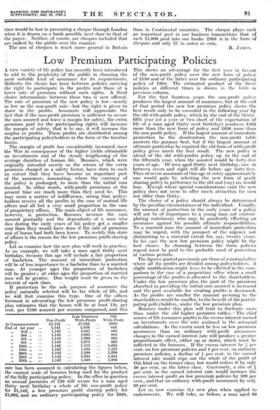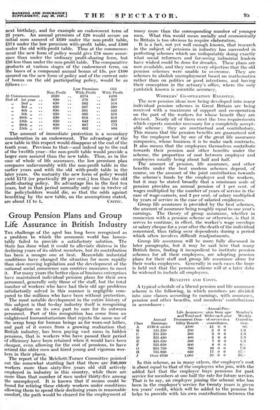Low Premium Participating Policies
ANEW variety of life policy has recently been introduced add to the perplexity of_ the public in choosing the most suitable kind of assurance for its requirements. Hitherto the choice has been- between policies carrying the right to participate in- the profits and those at a lower rate of premium without such rights. A third choice intermediate between these two is now offered. The rate of premium of the new policy is low—nearly as low as the non-profit. rate—but the right is given to share in the profits. Assurants will appreciate the fact that if the non-profit premium is sufficient to secure the sum assured and leave a margin for safety, the extra premium paid for the participating rights will increase the margin of safety, that is to say, it -will increase the surplus or profits. These profits are distributed among the participating policyholders in the form of the familiar bonus. _ - The margin of profit has considerably increased since the War in consequence of the higher yields obtainable on investments and of the steady lengthening of the average duration 'of human life. Bonuses, which were originally intended merely as the return of the extra premium Charged- as a safety factor, have risen to such an extent that they have become an important part of the assurance, amounting, where the currency of the policy is prolonged, to more than the initial sum insured. In other words, with-profit premiums at the present time are much more than they need be. This may seem a matter of indifference; seeing that policy. holders receive all the profits in the case of mutual life offices an& all but a very small proportion in the case of proprietary offiees_.__The main_ object of life assurance, however, is protection. Bonuses increase the sum assured gradually and the dependents of a man who dies during the early years of his policy get a smaller sum than they would have done if the rate of premium and of bonus had both been lower. To rectify this state of affairs is the reason for the low premium profit-sharing policy. Let us examine how the new plan will work in practice. As an example, we will take a man aged thirty next birthday, because this age will include a fair proportion of bachelors. The- amount of immediate protection will be of less importance to a bachelor than to a married man. At younger ages the proportion of bachelors will be greater ; at older ages the proportion of married men will be greater. Due weight must be given to the interest of each class.
If protection be the sole purpose of assurance the policy naturally selected will be for whole of life, and we will first examine this type. One of the offices foremost in advocating the low premium profit-sharing plan estimates that the bonus will be at least 15s. per cent. per £100 assured per annum compound, and this
At CommencemSnt End of 1st year ..
2nd „ Non-Profit £1,142 -..
1,142 ' ..
1,142 ..
Low Premium With-Profit £1,032 1,039 1,047 Old With-Profit - £828 846 866
3rd „
1,142
1,055 885
4th „
1,142 . 1,063 905
PP
5th „
1,142 .. 1,071 926
10th „
1,142 .. 1,112 1,034
15th „
1,142 . • 1,154 1,155
P.
20th ,, • • 1,142 • • 1,198 1,290
25th „ • . 1,142 . • 1,244 1,444
PP
35th „
1,142 . • 1,340 1,802
rate has been assumed in, calculating the figures below, the current scale of bonuSes being used for the product of the fully participating policy. In the office in question an annual premium of £20 will secure for a man aged thirty,next birthday a whole of life non-profit policy for £1,142, a low premium profit sharing policy for £1,082, and an ordinary participating policy for £828. This shows an advantage for the first year in favour of the non-profit policy over the new form of policy of £110 and of the latter over the ordinary participating policy of £204. The estimated -product of the three policies at different times is shown in the table in previous column.
For the first fourteen years the non-profit policy produces the largest amount of assurance, but at the end of that period the new low premium policy shows the best result only to be exceeded in the following year by the old with-profit policy, which by the end of the thirty- fifth year (or a year or two short of the expectation of life of a man aged thirty next birthday) produces £462 more than the new form of policy and £660 more than the non-profit policy. If the largest amount of immediate protection be the desideratum the non-profit table answers the purpose best, but if the largest amount of ultimate protection be required the old form of with-profit policy gives much the best result. The new policy is ahead of the old with-profits policy up to the end of the fifteenth year, when the assured would be forty-five years of age. Of men aged thirty next birthday, one in between seven and eight will die before age forty-five. Thus of seven assurants of this age at entry approximately one would gain by selecting the new form of profit sharing policy in preference to the old and (say) six would lose. Except where special considerations exist the new policy does not seem to offer much attraction for men not older than thirty. - The choice of a policy should always be determined by the peculiar circumstances of the individual. Usually, the amount of protection in the early years of a policy will not be of importance to a young man not contem- plating matrimony who may be prudently effecting an assurance against his possible ultimate responsibilities. To a married man the amount of immediate protection may be urgent, with the prospect of the urgency_ not diminishing to a, material extent for, say, twenty years. In his case the new low premium policy might be the best choice. In choosing between the three policies regard must be paid to the probable _need of protection at various periods.
The figures quoted previously are those of a mutual office where all the profits are divided among policyholders. A slight modification might have to be effected in the com- parison in the case of a proprietary office where a small percentage of the profits is allocated to the shareholders. Under the low premium plan the -part of the premium absorbed in providing the initial sum assured is increased and the part available for creating profits is decreased. As the profits are smaller the amount accruing to the shareholders would be smaller, to the benefit of the partici- pating policyholders, under the low premium plan. Bonuses under this plan will tend to • fluctuate More than under the old higher premium- tables.--The chief source of life assurance profits is the;excess-interest earned on investments over the rate aaslimed in the actuarial calculations. As the excess must be less on low premium assurances than on ordinary with-profit assurances changes in the earned interest rate will produce a greater proportionate effect, either up or down, which must be reflected in the bonuses. If the excess interest be 4 per cent. on low premium policies and 1 per cent. on ordinary premium policies, a decline of per cent. in the earned interest rate would wipe out the whole of the profit of this kind on the former class, but would reduce it by only 50 per cent. on the latter class. Conversely, a rise of per cent. in the earned interest rate would increase the excess interest profit on low premium policies by 100 per cent., and that on ordinary with-profit assurances by only 50 per cent. Let us now examine tl..e new plan when applied to endowments. We will take, as before, a man aged 30 next birthday, and for example an endowment term of 25 years. An annual premium of £20 would secure an initial sum assured of 2630 under the non-profit table, £574 under the low premium with-profit table, and £496 Under the old with-profit table. Thus at the commence- ment the new form of policy would give £78 more assur- ance than under the ordinary profit-sharing form, but 06 less than under the non-profit table. The comparative products at various stages of the endowment term, on the bases of a compound annual bonus of 15s. per £100 assured on the new form of policy and of the current rate Of bonus on the old participating policy, would be as f` flows :—
Old ' With-Profit £496 507 518 530 542 554 619 692 773 864
is a secondary consideration in an endowment. The advantage of the iiew table in this respect would disappear at the end of the tenth year. Previous to that—and indeed up to the end of the twelfth year—the non-profit table would provide a larger sum assured than the new table. Thus, as in the case of whole of life assurance, the low premium plan compares unfavourably with the non-profit table in the earlier years and with the old with-profit table in the later years. On maturity the new form of policy would yield £172 (or practically 20 per cent.) less than the old profit-sharing policy. Its advantage lies in the first ten years, but in that period normally only one in twelve of the policyholders would die, so that the odds against benefiting by the new table, on the assumptions stated,
Non-Profit Low Premium With-Profit At Commencement £630 ... £574 . .
End of 1st year . . 630 .. 578 • .
o 2nd „ .. 630 682 ..
o 3rd „ .. 630 587 • • „ 4th „ • • 630 591 • • ” 5th „ 630 595 ..
„ 10th „ 630 . 618 ..
fl 15th „
630 642
„ 20th „ .. 630 667 . .
„ 25th „ .. 630 . . 692 ..
The amount of immediate protection

















































 Previous page
Previous page